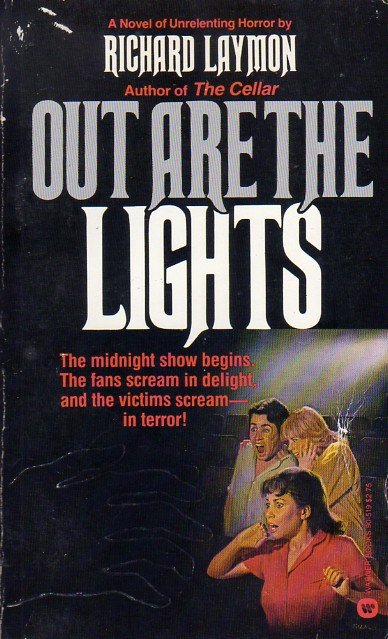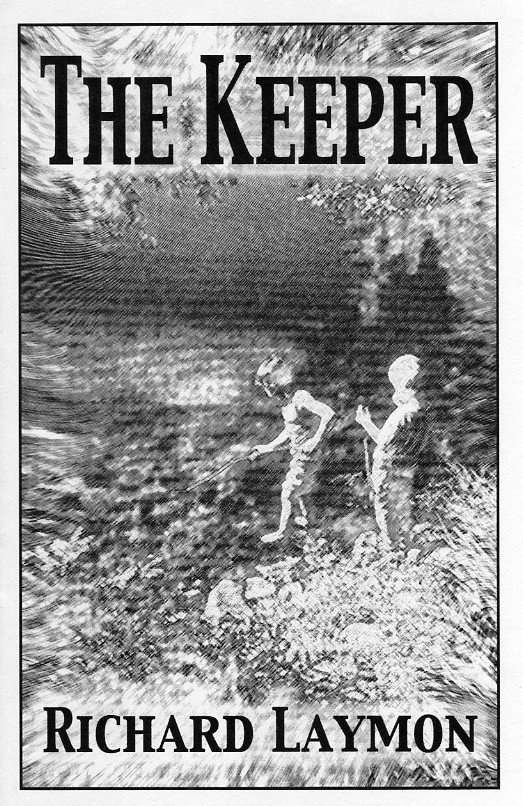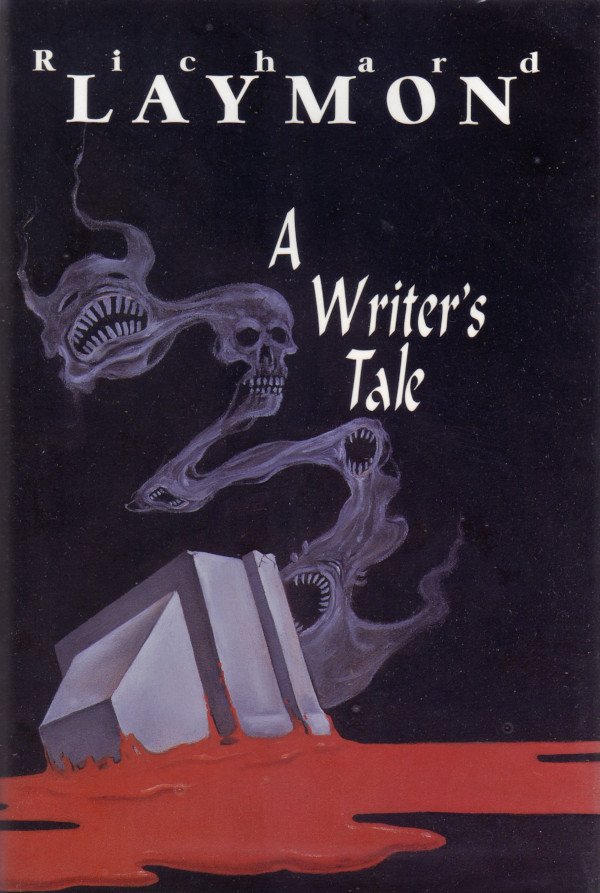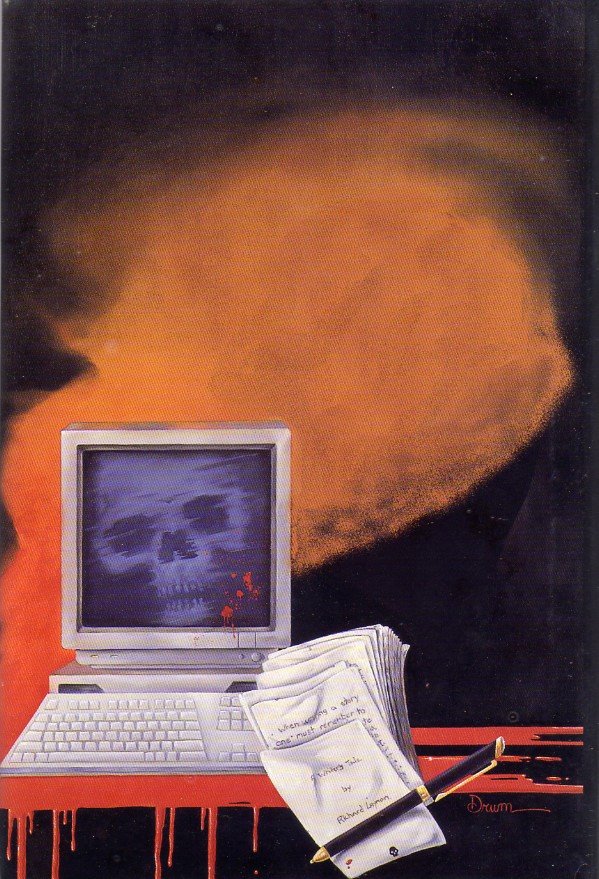Christmas has come and gone, but my holidays were filled with horror! As shown in the last installment, I'm still riding the Richard Laymon train, so let's have some fun celebrating my wins and bragging a bit.
As always, all images are scanned from my own sources, so grab your popcorn and settle in for another short romp through the pages with my favorite horror writer as we look at...
The Warner Editions: Out Are the Lights (1983, Warner Books)

This book is Laymon's nod to both horror films and the horror comics he read growing up (think E.C. Comics, Creepshow, and the like). It's a story about an amateur auteur director named Otto Schreck, who produces low-budget underground horror shorts with graphic special effects which seem too effective to be "special", if you catch my drift.
It's also the story of Connie, a young woman who catches on that Schreck's masterpieces are far more diabolical than the rest of the audience realizes, and sets out to prove it.
And it's the story of Dal, Connie's boyfriend, who winds up caught in a web of deceit and revenge with no way to escape. When these stories collide, the results are ruinous to all involved. This is a short, brutal, novel clocking in at 222 pages, all of which whiz by like the jackass in the next lane pushing through the intersection even though the light just turned red. It's not a great book, but it's far from Laymon's worst, and this edition is particularly difficult to find.
Out Are the Lights was the second of what was to be a three-book contract Laymon signed with Warner Books following the publication of The Cellar in 1980. Unfortunately, after their completely inept handling of The Woods Are Dark, the first of the three books in that contract, Laymon was less-than-certain that Warner had his best interests at heart.
Publication of Out Are the Lights proved just how disinterested in Laymon's career Warner could be. The front cover features teenagers who could have been ripped from the screen of Happy Days (tell me that's not Potsie and Joanie the uncredited artist used for inspiration). But the true disaster is the back cover which gives away all three of the book's major secrets/twists in a matter of two paragraphs. As Laymon put it, this was a case of the author getting stabbed in the back cover. He taped index cards over the spoilers when he gave out copies.
But Warner wasn't done with Laymon. While The Cellar and The Woods Are Dark at least received push from the company, along with cover blurbs from other writers (even if some of them were made up), Out Are the Lights was all-but-invisible, solicited and sold mainly via drug store paperback racks as opposed to book stores. Laymon's records indicate the Warner edition of Out Are the Lights sold roughly 28,000 copies.
Now 28,000 copies might sound impressive, especially when you're talking about a neophyte genre mid-lister like Laymon was at the time. But Laymon's previous book, The Woods Are Dark, despite receiving an editorial hatchet job nearly as grotesque as Otto Schreck's filmography, still sold over 70,000 copies. Laymon's debut, The Cellar, pushed a quarter of a million copies off shelves and into readers' hands. A ten-fold reduction in sales from his breakout novel signaled both the end of Laymon's partnership with Warner (who agreed that his three-book contract with them should be amended to a two-book contract), and the demise of his career in the US.
As with the Warner edition of The Woods Are Dark, this is a book for collectors and completionists only. It's far easier (not to mention less expensive) to find either the Headline UK hardcover or mass-market paperback edition, neither of which will spoil the story on the back cover or flyleaf. Expect to pay around $25-30 US for this one.
The Chapbooks: The Keeper (2001, Gauntlet Press)

The Keeper goes to show that no matter how much I learn about Laymon and his works, there's always more to unearth. This is what's known as a chapbook: a small, staple-bound printed booklet or pamphlet which typically receives limited distribution due to a small number of copies produced.
Now, I was aware Laymon had produced several chapbooks over the course of his life. They were all limited print runs, usually numbered in the hundreds of copies, and thus were scooped up by collectors early. Consequently when a Laymon chapbook comes up for sale, it commands a premium price, typically in the $100 ~ $150 range. That's always more than I can justify spending on one, so I just watch them come and go with a wistful sigh.
The Keeper is the exception which proves the rule. For some reason, despite being published in 2001, Gauntlet Press somehow still has copies of this chapbook available and in print, right now, for $10.
Like, how could I not, right? Especially when it's a story which does not appear in any of Laymon's anthologized short fiction, making this the only way to acquire a copy.
The Keeper is a dark-as-hell short story about two boys out fishing on a hot summer day, and the surprising piece of bait one of them has brought to the pond. It's part coming-of-age tale, part violent fantasy told the way only young boys can relate to one another things they aren't supposed to know, and ends on one final, disturbing revelation that forever changes the relationship the two boys have with one another from that day forward.
It's also one of the best things Laymon ever wrote.
Laymon's short fiction has always been hit-or-miss to me. When he gets it right, he does a great job. When he doesn't, the story crashes into the wall at 200 miles per hour and explodes. Bad Laymon fiction leaves a burnt-out crater in your skull for a few days.
But this is 8 pages of Laymon coming on stage, telling a story to the truest talents of his splatterpunk trappings, then bowing out and letting the dangling remainder speak for itself. Holy shit, is The Keeper aptly titled. With this story, Laymon took a keen-edged knife to my soul and shaved off just the tiniest portion to save for himself. He did it so quickly and skillfully it took me a few minutes after reading to notice anything was missing.
It's been three months since I first read it, and I still think about this story from time to time. For ten dollars, this was a steal. Thank you, Gauntlet Press, for keeping this in print for over twenty years. Now, if somebody could just do reprints of Tell Me A Tale, Out of the Attic, and In the Woods, pretty please?
The Grail: A Writer's Tale (1998, Deadline Press)

There is perhaps no book more sought-after for Laymon collectors than this. A Writer's Tale is Richard Laymon's autobiography, but it's the wildest autobiography you're ever likely to read. For within the pages lurk not only his observations on his own life and family history, along with some poems, short tales, photographs, and other ephemera (making this a great tie-in with the awesome In Laymon's Terms tribute anthology put out by Cemetery Dance), but also a complete breakdown of every novel he published between 1980 and 1997.
This is a writer pulling back the curtain, revealing the dark and twisted secrets behind where his ideas came from, the battles he fought to get some of them to publication, his opinions on the book industry, traps and pitfalls for novice writers to avoid, his suggestions for how to break into the business and stay relevant for as long as possible, and confessions of things he did of which he wasn't so proud upon looking back.
Between pages 217 and 324 are the answers to questions you've likely wanted to ask every writer who wrote a story you loved or hated: how did this come about, where did you get the idea, what the absolute fuck were you thinking, and so on and so forth. I'm not going to lie: I've read through this section and referenced it countless times in the past few months as I've been compiling research for my own Laymon-themed projects, including these various blog entries.
How do I know how many printings a specific book had? How many copies it sold? Where Laymon got the idea to do X, how he struggled with editors, fought with agents, won a battle, or saw something come out in a way he never imagined? Ninety-five percent of the time, it came from A Writer's Tale.
And if you want a copy for yourself, all I can say is, "Good fucking luck."
Deadline Press printed precisely 526 copies.
No, that's not a typo or a mistake. There are exactly five hundred and twenty-six copies of this book in existence. Five hundred of them are signed and numbered by Laymon on the title page. The remaining twenty-six came in a lettered, tray-cased edition along with a special chapbook containing the chapters of The Woods Are Dark Laymon was forced to cut for the original Warner paperback from 1981.
Unlike almost everything else Laymon wrote, there have been no other editions of this book published: no trades, no paperbacks, no reprints, and no digital editions.

In light of just how incredibly useful this book is for anyone seeking to know more about Laymon's own history and writing, the fact it's this rare and hard-to-find is an absolute crime. The fact I managed to lay my hands on one of the 500 signed and numbered versions without needing to take out a second mortgage still astounds me.
I am one lucky son of a bitch.
Thanks for once again checking in on my obsessive quest to document everything Laymon. I hope you will continue to share your own excellent collections with the community, and whatever you do, don't stop reading.
Well, I managed to get my spooky book fan to read a few Laymon novels, essentially on your recommendation since you've been writing about them off-and-on for s long, but now she is reading Nora Roberts. Feh. There's no accounting for taste.
Nothing wrong with Nora Roberts! She's been doing her thing for decades, and she's quite good at it. I've read a couple of her books (Sanctuary under her own name, and the first Eve Dallas book under her "J.D. Robb" pseudonym), and enjoyed them.
Of course, if you can bring her back into the horror fold, then so much the better... >:)
I have a distrust of authors that prolific. I know James Patterson basically heads a ghostwriter crew, so it's hardly his work so much as his brand name. I'm told Danielle Steel is terribly formulaic. At least Nora Roberts/JD Robb circulates enough to justify most of her shelf space, but that real estate is at a premium in my little library.
Your content has been voted as a part of Encouragement program. Keep up the good work!
Use Ecency daily to boost your growth on platform!
Support Ecency
Vote for new Proposal
Delegate HP and earn more
Congratulations @modernzorker! You have completed the following achievement on the Hive blockchain and have been rewarded with new badge(s):
Your next target is to reach 115000 upvotes.
You can view your badges on your board and compare yourself to others in the Ranking
If you no longer want to receive notifications, reply to this comment with the word
STOPCheck out the last post from @hivebuzz: